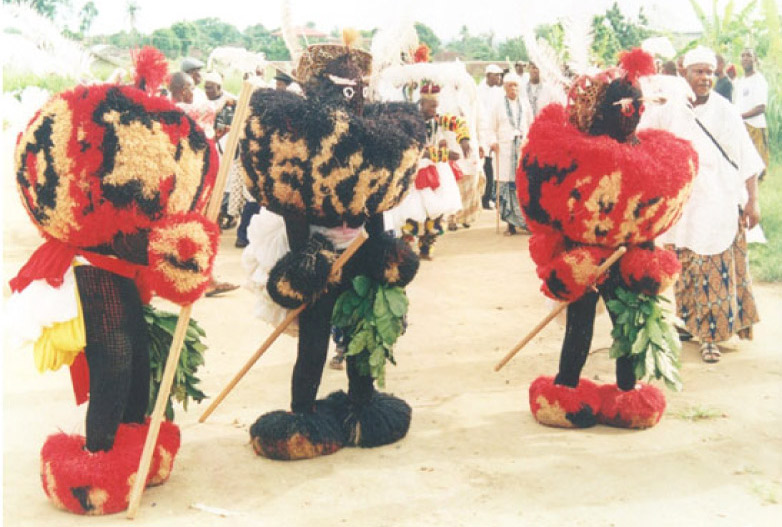Culture & Tradition
The Prestigious Ekpe Masquerade of Calabar

\ Updated : 6 December, 2020 by Koko Esin
"Ekpe" which literally means Lion, is a traditional secret society originated from the Ekoi tribe in Cross River State. The masquerade tradition itself is most popular in Calabar and the Oron nation of Udung-Ukko, Mbo, Urue-Offong Oruko, Okobo, as well as the Eket and Uruan local government areas in Akwa Ibom state, Nigeria, and even western Cameroon. The Efik (Calabar) caste structure of Ekpe begins with the basic masquerade - Idem Ikwọ to Nyamkpe which is the most common of the highest level displayed only by senior mantle bearers. Members of this sacred cult are endowed as protectors of societal order along with the traditional ruler. We have a set of communication methods known as Nsibidi which includes two thousand year old writing system with some of the symbols commonly found inscribed on the Ukara (leadership) attire. Nsibidi also includes special gesture communications and ancestoral vocalizations that can only be understood, interpreted and responded to by senior members of the cult.
In the ancient times and as recently as the 17th Century CE, the driver/bearer of the masquerade was an invoked ancestor who was the leader or high-ranking member of the cult and no one would know the actual identity of the long dead ancestor, not even the members of the secret society. However, in modern times, the tradition has evolved away from deep spirituality and remained only notable as symbolic culture. The bearer of the masquerade in this age is a living man who goes through an intense ritual and pouring of libation to ask permission, wisdom and guidance of the ancestors before he bears the responsibility of driving the masquerade.
Unlike "Ekpo", the Ekpe is not a variety of masquerade cults but one traditional cult with the same core values known in different localities by slightly different names - mainly Ekpe and Mkpe; and it is always the highest and most prestigious masqurade in the locality where it exists, just like the lion is known to be the king of its habitat. As many Ekpe rituals and ceremonies require utmost masculinity, celebacy and purity, women are traditionally prohibited from proximity to any aspect of the cult except for wives and daughters of high ranked members who are ceremonially initiated as distant observers rather than participants. However, women have their counterpart high-status matrachical societies like Abang, Ekombi or Moni-Nkim from which men are strictly forbidden. In ancient times, it was typical for young females to be initiated into one of the highly esoteric female societies while young boys would attain their highest disciplines within the the Ekpe masquerade clan. In its vastness, the Ekpe is a well structured society with semi-caste characteristics, in that, there are categories and titles which one may qualify to be initiated into, while others are strictly reserved for persons of certain status and backgrounds. However, based on merit, one from a lower category may find favour being initiated to a higher level if he successfully completes the necessary rituals and tough tests that may last for weeks.
The Ekpe parades traditionally happen at the end of every year over a period of seven days (Ukabade Isua) in which many ekpe perform spiritually guided walks that includes the Iyiro/Nyiro (random spins) from a certain starting point in town to the palace of the traditional ruler. The ruler and a senior member of the cult would perform libations of white wine or other spirits to honour the founding fathers by calling out their names after the expression"Oje Oje Bari Bari" (which means "order" in old Ejagam language) followed by the subject - names of proximal clans and localities in which the cults dwell, suggesting unity.
The most noticeable element of the Ekpe cult artform is the masquerade itself which is designed originally red and black but also (though rarely in other colours) with a big round glituans worn at the upper body section to represent the mane of a lion and small versions around the ankles called "mkpat etim," and smaller versions around the wrists called "Itong Ubok Etim". The masquerade holds a bunch of oboti leaves in the left hand and a long staff in the right. What the two symbolize cannot fully be established beyong spiritual authority and leadership authority, consecutively. However, in ancient times, it was popular that is the Ekpe strikes a person with the leaves, there was hope as that simply meant casting out the evil from the person. On the other hand, if the Ekpe struck the person with the staff, that would be the end. Although the Ekpe cult has different factions in different areas across the cross river region, they all communicate in the same Nsibidi gesture and symbols. If one group comes face to face with another group on the street, one must prove its originality by giving accurate response to a certain Nsibidi (usually a non-verbal riddle). If the other group gives a the correct non-verbal answer, it validates its genuinness and the groups can move on peacefully. An inability to solve the riddle would indicate that the group is fake and therefore would face the full wrath of the original cult.
The Ekpe cult is not a typical dance group and stands out as one of the most prestigious masquerades in West Africa, in that though it appears to be just an art form during the Ukabade Isua festival, it operated as a complete civilized society within a larger society, serving as law enforcement, judiciary, and even spiritual consultation. As tradition has it, the senior members of the cult also initiated, trainned and coronated rulers of the land. Even till this day, though the influence of the cult slowly fades due to globalization priorities and lack of interest in young people to carry-on this tradition, the Ekpe remains the custodian of the Efik cultural heritage.





